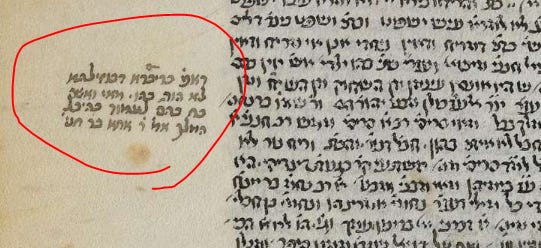The other day, on Sanhedrin 93, we encountered Bar Kochba. Thus:
בַּר כּוֹזֵיבָא מְלַךְ תַּרְתֵּין שְׁנִין וּפַלְגָא. אֲמַר לְהוּ לְרַבָּנַן: אֲנָא מָשִׁיחַ. אֲמַרוּ לֵיהּ: בְּמָשִׁיחַ כְּתִיב דְּמוֹרַח וְדָאֵין, נֶחְזֵי אֲנַן אִי מוֹרַח וְדָאֵין. כֵּיוָן דְּחַזְיוּהּ דְּלָא מוֹרַח וְדָאֵין, קַטְלוּהּ.
The Gemara relates: Bar Koziva, i.e., bar Kokheva, ruled for two and a half years. He said to the Sages: I am the Messiah. They said to him: With regard to the Messiah it is written that he is able to smell and judge, so let us see ourselves whether he, bar Kokheva, is able to smell and judge. Once they saw that he was not able to smell and judge, the gentiles killed him.
As someone mentioned the other day in the daf yomi shiur, Rav Steinsaltz explained the history behind it. I didn’t see it inside, but I’ll elaborate on the idea. It seems his actual name was Shimon bar Kosiva, בר כוסיבה with a samech. When people thought he was mashiach, they called him Bar Kochva, referring to a star, kochav. When that didn’t pan out, they called him Bar Koziva, with a zayin, כזב, meaning something that lied or did not fulfill its promise. Yeshaya speaks of וּכְמוֹצָא מַיִם אֲשֶׁר לֹא־יְכַזְּבוּ מֵימָיו, “Like a spring whose waters do not fail.”
Here, via Wikipedia, is an letter penned by Bar Kochba, where he refers to himself in the top line with a samech, Kosiva.
So depending on hope or disappointment, the word was modified via wordplay.
Rav Aharon Hyman discusses Bar Koziva here, but doesn’t come to this conclusion. He didn’t have the same access to sources that we have.
Printings and manuscripts all have Bar Koziva, but I noticed a few interesting points in some manuscripts.
First, in Yad HaRav Herzog, there’s an insertion about Rabbi Akiva’s endorsement of Bar Koziva.
[Edit: After writing the above in draft, I noticed this Facebook post by Hillel Gershuni, and also this article on Kikar, pointing out that the Rambam makes this statement that the Rabbi Akiva was the Nosei Keilav of Bar Kochba. But everyone wondered where Rambam got this, since it was not in any statement of Chazal. Except, they note, it turns out that it is, because here’s a manuscript of Sanhedrin that has it.]
Second, Munich 95:
I think the transcriber noticed some smudge-out and rewriting (?), so the transcription גו'· בר (( ...... )){כוזיב'} ~מלך תרתין. Could there have been a different spelling of koziva here?
Finally, the gemara continues:
דָּנִיֵּאל חֲנַנְיָה מִישָׁאֵל וַעֲזַרְיָה, דִּכְתִיב בְּהוּ: ״אֲשֶׁר אֵין בָּהֶם כׇּל מְאוּם וְטוֹבֵי מַרְאֶה וּמַשְׂכִּילִים בְּכׇל חׇכְמָה וְיֹדְעֵי דַעַת וּמְבִינֵי מַדָּע וַאֲשֶׁר כֹּחַ בָּהֶם לַעֲמֹד בְּהֵיכַל הַמֶּלֶךְ וּלְלַמְּדָם סֵפֶר וּלְשׁוֹן כַּשְׂדִּים״.
Six virtues were ascribed to Daniel, Hananiah, Mishael, and Azariah, as it is written in their regard: “Youths in whom was found no blemish, and well favored, and skillful in all wisdom, and discerning in knowledge, and perceptive in understanding, and who had strength in them to stand in the king’s palace, and whom they might teach the learning and the tongue of the Chaldeans” (Daniel 1:4).
מַאי ״אֲשֶׁר אֵין בָּהֶם כׇּל מוּם״? אָמַר רַבִּי חָמָא בַּר חֲנַנְיָא: אֲפִילּוּ כְּרִיבְדָּא דְכוּסִילְתָּא לָא הֲוָה בְּהוּ.
The Gemara asks: What is the meaning of the phrase “in whom was found no blemish”? Rabbi Ḥama bar Ḥanina says: Even a scratch like the wound that remains after bloodletting was not found in them.
While that seems right, Munich 95 has the word דְכוּסִילְתָּא with a zayin instead. Also, Rabbi Chama bar Chanina didn’t necessarily say this lancet / bloodletting bit, but says the following statement.
Instead, this segment appears in a marginal insertion.








